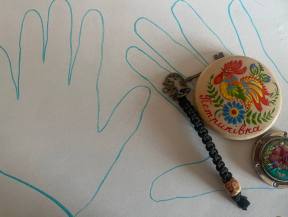Another title for this activity could be ‘What Are You?’ Invite students to look at their bags, pockets, or even desks. What objects do they see? Are they all random objects? Are there any special ones for them, for any reason? Let them pick three to five items to focus on.
One way to illustrate this is to show what you have in your bag. This may, however, limit the students’ choices and creative thinking. Another way would be to remind them that no correct answer exists, and as we are all unique and different, the items we pick will be different, too. This is what makes the task interesting!
Ask students to outline their hands, right and left, on a page of their notebook. Inside the right hand, ask them to draw the selected items (instead of drawing, they can make a simple outline).
Offer some questions to think about. If the level of the group is B1 and higher, encourage them to make brief written notes in the other hand’s outline:

Two out of three items surprised me today. Can you guess which ones?
- What do/might the objects tell you about your values? How do they show what you feel is important for you in life (not only school)? For example, if you have a water bottle, you care about a healthy lifestyle and also try to be more ‘green’ in your everyday choices and avoid plastic.
- Do any of the items reflect the dreams you have or your vision about who you want to be or become in the future? How can you add such a reminder to your everyday things?
- Do any of the items tell us about who you are?
Let students work in pairs or small groups and show the items to each other, answering all or some of the questions. Depending on the amount of time you have, you can let them talk in a new pair.
As a follow-up and reflection, especially if time allows, let students read the questions below and choose one to discuss in their pairs or small groups.
- Having talked to the others in the group, is there anything you would like to add to your items (for example, you also have a key ring that brings a special memory, etc.)?
- What have you noticed (about your objects) just now that you have not thought about before? Are there any new insights about yourself?
- Out of the three questions, which one was the hardest to answer? Why do you think this is?
A couple of thoughts at the end
It is quite possible that not all the students would come up with a deep reflection about the items around them. Not everyone carries a list of important items around, and the objects in our pockets do not always represent a special symbol or hide a big meaning. I would say follow your instinct here, knowing the students in the group and the culture you are in. You can modify the questions to ask (e.g., ‘What is the most surprising object found in your pocket?’ could be fun to explore) or you can ask students to add their own.
One idea students may find interesting is how a small item in their bag, such as the key in my picture, could be there for a reason and serve as a reminder (the key to making decisions and to being the author of the responses I make to what is happening). Sometimes, small things can be in our hands in terms of how we act or think, and this activity can help them (re-)discover this.
So… what’s around you today? I am curious how this goes in your classroom in different parts of the world (online or offline). Let me know!
Thank you for reading! 🙂
**More activities from ‘It’s in (Y)Our Hands!’ series can be found here.
